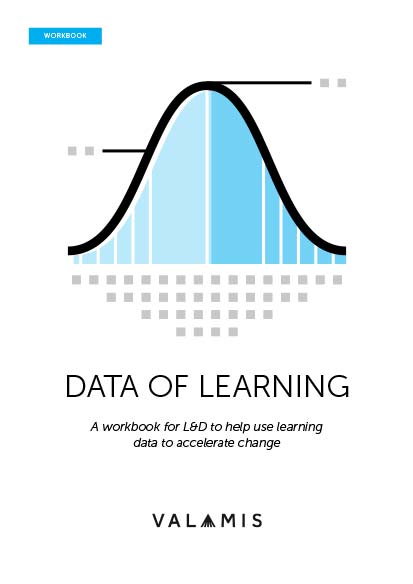10 Valuable Training Metrics to Know
Developing employees is critical to the success of any business. However, Learning and Development (L&D) requires investment, and ineffective or misguided training wastes considerable time and resources.
So how do organizations determine the success of their training programs? They need provable outcomes defined by measurable data. Discover:
- What are employee training metrics?
- How to identify the right metrics for your training program?
- 10 valuable training metrics to know
- Where to source learning metric data?
- Infographic: Learning metrics
What Are Employee Training Metrics?
Training metrics are the methods of quantifiably tracking and validating the effectiveness of a training program. They include a range of specific, sometimes customized, measures that aim to reflect the impact of an organization’s L&D efforts.
Before every training program, organizations should define their desired goals and outcomes – what they hope to achieve from new educational courses.
Then, by gathering data throughout the process and carefully analyzing real-life results, learning metrics offer a way of accurately assessing the strengths and weaknesses of a particular course to determine whether it achieved its goal.
Employee training metrics are extensive, varied, and often adapted to specific training programs. For example, organizations may want to track different metrics for onboarding or compliance training compared to upskilling or reskilling initiatives.
General areas learning metrics cover include:
- time spent consuming training content (e.g., hours logged on various eLearning modules);
- the number of employees successfully completing training (e.g., test scores from program assessments);
- a way of mapping training outcomes to operational improvements (e.g., resulting behavioral changes);
- or an evaluation of the financial impact of a specific course (e.g., financial return or ROI).
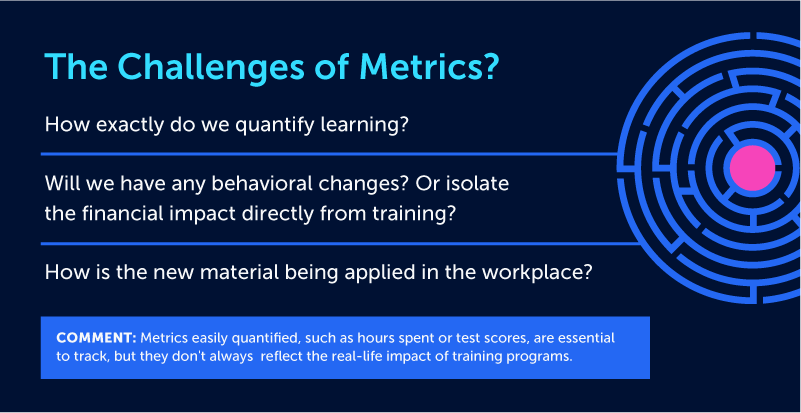
However, listing metrics like this doesn’t consider the challenges associated with accurately defining many of them. For example:
- How exactly do we quantify learning?
- How do we quantify behavioral changes?
- or How we isolate the financial impact directly from training?
Learning is always specific to each employee and requires personal context. Metrics easily quantified, such as hours spent or test scores, are essential to track, but they don’t actually reflect the real-life impact of training programs.
To measure learning and how it affects an employee’s work requires deeper analysis, data gathering, and information from other systems (i.e., employee performance metrics before and after training).
Covering these areas and more allows an organization to evaluate its training processes and discover ways to improve in the future.
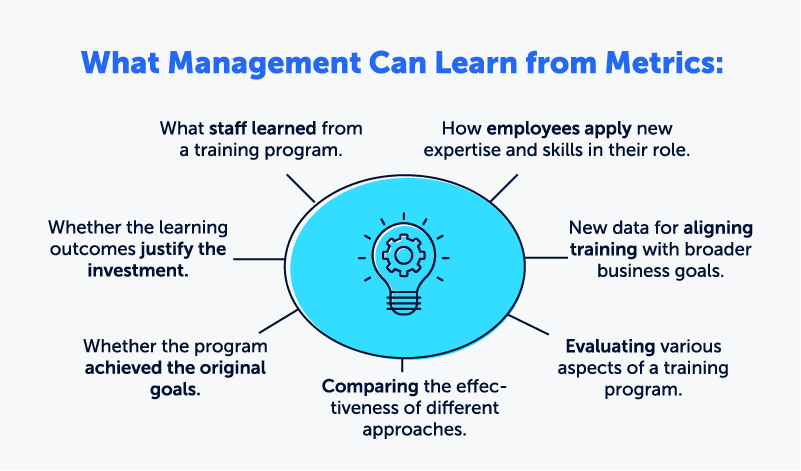
Successfully implementing metrics for training offers management insight into:
- What staff learned from a training program
- How employees apply new expertise and skills in their role
- New data for aligning training with broader business goals
- Evaluating various aspects of a training program
- Comparing the effectiveness of different approaches
- Whether the program achieved the original goals
- Whether the learning outcomes justify the investment
Learning metrics and the information they provide help to guide future L&D decision-making.
Metrics for training assessment are sometimes compared to Key Performance Indicators (KPIs).
However, KPIs track overall business performance and goals, and training metrics are more targeted. They evaluate training effectiveness and whether a program solves a particular problem.
How to Identify the Right Metrics for Your Training Program?
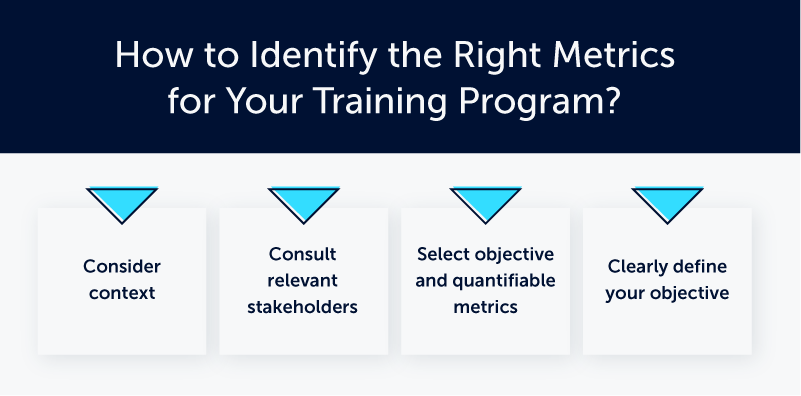
With many learning metrics to choose from, organizations need to identify the ones that best reflect the effectiveness of their programs.
1. Consider Context
Always consider the context of the training.
What are the learning objectives? What learning model are you implementing? And what department is it tailored towards?
Metrics for learning should reflect training type and if a specific model is being utilized. For example, is the training asynchronous or blended? How is attendance measured, and how are attendees assessed?
Training a sales team is very different than training HR staff, and this context can help guide you when selecting relevant learning metrics. Consider the specific department’s role, the factors that affect it, and what the desired outcome should be.
To successfully assess training effectiveness, you should first consult department heads and their employees.
2. Consult Relevant Stakeholders
Beyond department heads, L&D staff should consult a range of relevant stakeholders to determine appropriate learning metrics.
What does each stakeholder hope to gain from the training program? And what are the key indicators they believe capture this the best?
The best way to accurately measure training effectiveness is to talk to the people closest to the situation. This includes line managers, supervisors, employees who previously underwent the course, and staff who will soon take it.
3. Objectivity
Better results are generally found when selecting objective, quantifiable metrics for training that rely on data rather than opinion.
Note: Unfortunately, many factors can sway subjective metrics, and they are often hard to validate.
4. Clearly Define Your Objective
Perhaps the most critical factor to consider when evaluating training effectiveness is the big-picture goals of the program. Whether they are clearly defined: increase sales by X%, or less tangible: improve collaboration between teams, your choice of learning metrics should be the direct result of the overall objective.
Objectives more difficult to define, such as employee collaboration, require a clear plan for assessment, for example, employee surveys before and after training.

10 Valuable Training Metrics to Know
There are many learning metrics available to evaluate training effectiveness. Plus, organizations can develop custom metrics incorporating factors specific to their business or approach to training.
Metrics for assessing the effectiveness of training should be based on real-life data and attempt to honestly reflect the outcomes of L&D efforts.
Below we have listed ten learning metrics that represent a good starting point for organizations looking to analyze their training effectiveness.
Note: Many of these metrics are general enough to be defined in a simple equation, while others require further analysis to generate the necessary data. Where applicable, we have provided equations demonstrating how to calculate the final metric.
Analytics ≠ kompliziert
Mehr erfahren
Fühlen Sie sich gefangen in einem endlosen Kreislauf aus Zertifizierungsverfolgung und dem Zwang, die Mitarbeiter zur Einhaltung der Vorschriften anzuhalten?
Lassen Sie sich von Valamis helfen, indem Sie spezielle Lernpfade erstellen, die Ihre Mitarbeiter mit Erinnerungen auf dem Bildschirm und Push-Benachrichtigungen daran erinnern.
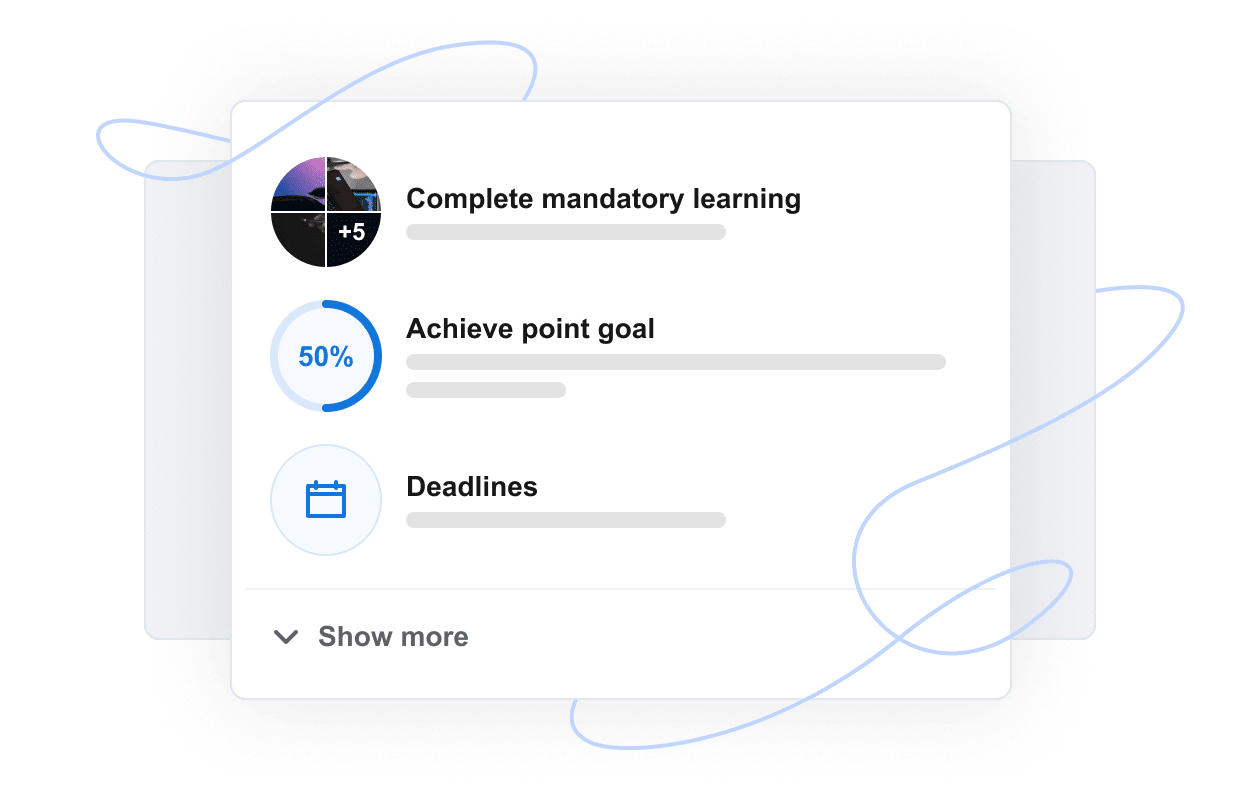
1. Completion Rate

Completion rate = Number of employees completing course / Number of initial participants
Course completion rate measures the number of employees who finish the entire program compared to the number of people who started.
It shows how many people make it to the end, covering all the material. However, it does not include information regarding participant performance.
2. Pass Rate

Pass rate = Number of employees passing course / Number of participants
Most courses include assessments of some form, often with a pass/fail criteria. Employees above a certain level are deemed to pass the course, acquiring new knowledge or developing new skills
The pass rate of a training program demonstrates the ratio of employees successfully passing the course’s assessment.
3. Participant Engagement
The level of engagement generated strongly correlates to the success of the course. While engagement is a complex parameter to quantify, course leaders have several options.
For example, they can track time spent with the course material or attempt to measure the effort employees invest in the program.
Generally, this information should be used alongside other data such as the pass rate, employee performance metrics, or more subjective feedback, including post-training surveys.
4. Training Cost Per Employee

Training cost per employee = Total training cost / Number of participants
The training cost per employee is the total cost divided by the number of participants.
This metric can be applied to specific programs or an organization’s entire L&D operation. Training cost per employee is an excellent way to understand how much an organization invests in its workforce’s development.
To accurately define total training costs, organizations should consider the time spent on both formal and informal training.
For example, how long did employees spend on traditional training scenarios (i.e., classroom style, webinars, etc.), informal self-taught training (i.e., eLearning modules), and how much time and money did it take to travel for training opportunities?
5. Training Return on Investment

Training ROI = Change in profit as a result of training / Total cost of training
The bottom line of every training program is: how much value it generates compared to how much it costs. Therefore, training ROI is a critical metric to determine whether the program was successful.
However, calculating a final value can be difficult, as organizations need to isolate the change in profit that is a direct result of the training.
Note: Simply looking at profit before and after could mislead organizations with the training program taking credit for other factors affecting business performance.
6. Employee Performance Metrics
Most businesses utilize employee performance metrics, assessing how well each staff member is doing. By comparing these metrics before and after training, companies can determine if the newly acquired knowledge or skills lead to better performance.
Depending on the employee’s role and the type of training, this may be relatively simple to notice or take some time to filter through and affect the final performance metrics.
7. Sales Close Rate

Sales close rate = Successful sales no. / Number of inquiries
An example of a simple employee performance metric is the sales close rate. It measures the performance of a sales team by comparing the number of successful sales to the number of inquiries.
Are employees converting interested parties into paying customers?
Comparing the sales close rate pre and post-training, leadership can imply the effectiveness of a given program.
8. Customer Satisfaction Rating

Customer satisfaction rating = Number of positive responses / Total responses
A fundamental goal of every business should be providing a good service and generating happy customers. Many training programs aim to improve customer satisfaction.
The easiest way of measuring any change in customer satisfaction is by tracking the ratio of positive responses to total responses during customer feedback.
9. Change in Operational Efficiency

Change in OE = OE before training / OE post training
Training staff, making them better at their jobs, and filling specific skills gaps should increase operational efficiency. You can assess its impact by comparing Operational Efficiency (OE) before and after training.
Operational efficiency can cover many aspects of the organization and be measured in many different ways.
In addition, it is often specific to a given industry. For example, logistics companies might measure the total output of the facility or the percentage of deadlines met. In contrast, a company based on customer sales might measure the revenue per customer.
10. Patterns in Participant Behavior
A more in-depth learning metric, analyzing patterns in employee behavior before, during, and after training, can help identify issues.
Perhaps staff from a single department are consistently underperforming, or specific employees struggle with the existing approach to learning (e.g., more visual learners who aren’t currently catered to effectively).
Where to Source Learning Metric Data?
All of these metrics are only as good as the data they are based on.
So how should organizations go about gathering this data?
Businesses have several options available to them:
- Learning Management System (LMS) – software designed to manage the delivery of educational content.
- Learning Experience Platform (LXP) – software to create a personalized learning experience.
Both of these tech solutions allow L&D staff to track detailed information on course participants from a single software package. This includes the training material, courses, and programs for each individual, their time with each module, their completion rate or assessment scores, and any related performance metrics.
While housing everything in a single comprehensive software platform can simplify gathering learning metric data, many people aren’t ready to invest in one.
Other options available include:
- Surveys – gathering direct feedback from course participants to better understand their learning and whether it will impact their day-to-day work.
- Focus Groups – while surveys are typically forms, focus groups gather participants together to ask interactive questions and gather feedback through honest conversations.
Infographic: Learning Metrics

